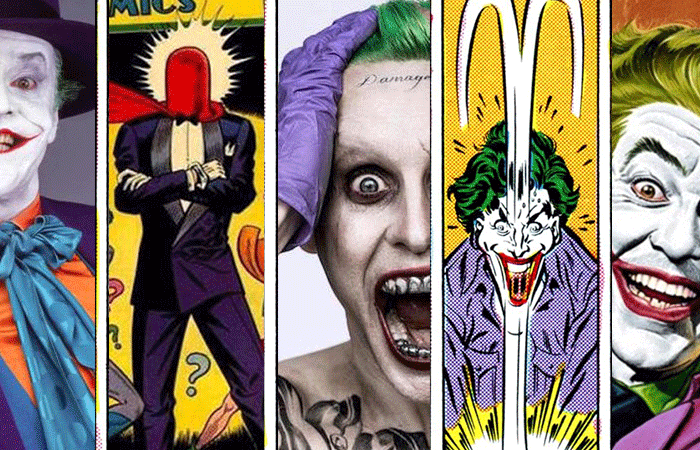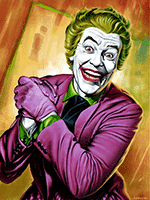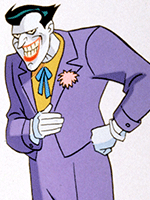The Evolution of the Joker’s Style
 Like the length of Batman’s ears or the shade of Superman’s tights, everyone’s got an opinion on how the Joker is supposed to “look.” This week, photos emerged of Jared Leto’s new Joker from the upcoming Suicide Squad movie revealing his emo-dance club tattoos, and it isn’t exactly a traditional take on the character. However, the Joker’s style has been changing subtly, and not so subtly, for a long, long time. Here’s a rundown of a few iconic Jokers.
Like the length of Batman’s ears or the shade of Superman’s tights, everyone’s got an opinion on how the Joker is supposed to “look.” This week, photos emerged of Jared Leto’s new Joker from the upcoming Suicide Squad movie revealing his emo-dance club tattoos, and it isn’t exactly a traditional take on the character. However, the Joker’s style has been changing subtly, and not so subtly, for a long, long time. Here’s a rundown of a few iconic Jokers.
Red Hood
 The Joker’s origin story has shifted somewhat over the decades, but the emergent, most established, and accepted version deals with a down-on-his-luck guy, and a tragedy. The Joker was once a failed stand-up comedian who, because of some bad debt, got mixed up in pulling of a heist for some criminals. This required him to become “The Red Hood,” a villain who wore a tuxedo and, yes, a red hood over his head. The thing is, “The Red Hood” could have been anyone and when the proto-Joker was disguised as him, a moving target. During a botched job at a chemical factory, he fell into a vat of acid and became the insane Joker. This storyline is mostly established in The Killing Joke, but is echoed in the graphic novel Batman: Noel (2011), the animated movie Under the Red Hood, and numerous other storylines. Fashion takeaway: the Joker wears slightly formal attire because the Red Hood did, too.
The Joker’s origin story has shifted somewhat over the decades, but the emergent, most established, and accepted version deals with a down-on-his-luck guy, and a tragedy. The Joker was once a failed stand-up comedian who, because of some bad debt, got mixed up in pulling of a heist for some criminals. This required him to become “The Red Hood,” a villain who wore a tuxedo and, yes, a red hood over his head. The thing is, “The Red Hood” could have been anyone and when the proto-Joker was disguised as him, a moving target. During a botched job at a chemical factory, he fell into a vat of acid and became the insane Joker. This storyline is mostly established in The Killing Joke, but is echoed in the graphic novel Batman: Noel (2011), the animated movie Under the Red Hood, and numerous other storylines. Fashion takeaway: the Joker wears slightly formal attire because the Red Hood did, too.
Caesar Romero (Batman, 1966)
 There’s almost never an incarnation of the Joker that doesn’t have the purple suit, the white face, and the green hair. But in the famed 1960s version of the Batman-universe, the Joker also had a mustache. Under the white make-up of Caesar Romero’s Joker is a very visible, dark mustache. According to many (specifically Adam West) this is because Romero refused to shave, believing it still made him look dashing underneath the white make-up. Another interpretation is that the mustache under the make-up was an intentionally kitschy choice from producer William Doizer, making the Joker comic in more than the obvious way; he was oblivious to how silly his mustache looked.
There’s almost never an incarnation of the Joker that doesn’t have the purple suit, the white face, and the green hair. But in the famed 1960s version of the Batman-universe, the Joker also had a mustache. Under the white make-up of Caesar Romero’s Joker is a very visible, dark mustache. According to many (specifically Adam West) this is because Romero refused to shave, believing it still made him look dashing underneath the white make-up. Another interpretation is that the mustache under the make-up was an intentionally kitschy choice from producer William Doizer, making the Joker comic in more than the obvious way; he was oblivious to how silly his mustache looked.
1970’s/80’s Comic Book Joker
 The large laugh and the angular features certainly started in the 1960s incarnation of the Joker, but became more defined in the 1970s and ’80s. In this era, the Joker would occasionally sport a hat, and definitely had a few trick-lapels that often contained insane, murderous chemicals, rather than, you know, water. The most recognizable Joker from this period is probably the one who appears in Death in the Family, which features the death of then-Robin, Jason Todd.
The large laugh and the angular features certainly started in the 1960s incarnation of the Joker, but became more defined in the 1970s and ’80s. In this era, the Joker would occasionally sport a hat, and definitely had a few trick-lapels that often contained insane, murderous chemicals, rather than, you know, water. The most recognizable Joker from this period is probably the one who appears in Death in the Family, which features the death of then-Robin, Jason Todd.
Jack Nicholson (Batman, 1989)
 While competition for the best portrayal of the Joker is very stiff, for many this was the performance and style to beat. With his high pants, wide-brimmed hat, and over-the-top comic book look, Nicholson’s joker both redefined and held true to what we thought the Joker should look and act like. His origin story also wasn’t that far off from some of the Red Hood action, either. And while we see this particular outfit and over-the-top performance as cornynow, the fact is that in 1989 this was a seriously dark Joker.
While competition for the best portrayal of the Joker is very stiff, for many this was the performance and style to beat. With his high pants, wide-brimmed hat, and over-the-top comic book look, Nicholson’s joker both redefined and held true to what we thought the Joker should look and act like. His origin story also wasn’t that far off from some of the Red Hood action, either. And while we see this particular outfit and over-the-top performance as cornynow, the fact is that in 1989 this was a seriously dark Joker.
Mark Hamill, Batman: The Animated Series/Batman Beyond
 Like Kevin Conroy’s portrayal of the voice of Batman, Mark Hamill has probably played the Joker more than anyone else, in terms of sheer hours logged in the role. Though never in a live-action situation, Hamill’s voice has completely solidified for nearly everyone how this insane clown-prince of crime is supposed to sound. Notably, this Joker isn’t always portrayed with green hair, but instead retains the more old-school slicked-back, almost fancy restaurant waiter look. Maybe because this Joker was crafted for a cartoon, he never come across as physically grotesque, but instead, just a crazy guy who dresses up in a purple suit, but otherwise looks fairly slick.
Like Kevin Conroy’s portrayal of the voice of Batman, Mark Hamill has probably played the Joker more than anyone else, in terms of sheer hours logged in the role. Though never in a live-action situation, Hamill’s voice has completely solidified for nearly everyone how this insane clown-prince of crime is supposed to sound. Notably, this Joker isn’t always portrayed with green hair, but instead retains the more old-school slicked-back, almost fancy restaurant waiter look. Maybe because this Joker was crafted for a cartoon, he never come across as physically grotesque, but instead, just a crazy guy who dresses up in a purple suit, but otherwise looks fairly slick.
Heath Ledger (The Dark Knight, 2008)
 With his grungy unkempt hair and horrifying facial scars, Ledger’s joker was a visual departure from the more spiffy Joker we got used to with Mark Hamill or Jack Nicholson. Thematically though, Ledger’s Joker was more similar to what the comics had been doing with the character since the 1990’s. Interestingly, the appearance of Leger’s Joker is very connected to the way he was drawn in a graphic novel illustrated by Lee Bermejo called simply Joker. Since Bermejo started work on this title in 2006, it’s not totally clear how much his style of Joker influenced the production of The Dark Knight, but they look exactly the same.
With his grungy unkempt hair and horrifying facial scars, Ledger’s joker was a visual departure from the more spiffy Joker we got used to with Mark Hamill or Jack Nicholson. Thematically though, Ledger’s Joker was more similar to what the comics had been doing with the character since the 1990’s. Interestingly, the appearance of Leger’s Joker is very connected to the way he was drawn in a graphic novel illustrated by Lee Bermejo called simply Joker. Since Bermejo started work on this title in 2006, it’s not totally clear how much his style of Joker influenced the production of The Dark Knight, but they look exactly the same.
Jared Leto (Suicide Squad, 2016)
 He’s younger! He’s got a lot of buttons unbuttoned! He’s got crazy laughing tattoos! Do we like it? Almost every time there’s an early photo of a superhero/super villain from an upcoming movie, people freak out and worry that it’s going to suck, but it almost always ends ups being fine. Leto is a solid actor, so maybe his faux-emo-punk Joker is going to be awesome. One thing is for sure, it’s different.
He’s younger! He’s got a lot of buttons unbuttoned! He’s got crazy laughing tattoos! Do we like it? Almost every time there’s an early photo of a superhero/super villain from an upcoming movie, people freak out and worry that it’s going to suck, but it almost always ends ups being fine. Leto is a solid actor, so maybe his faux-emo-punk Joker is going to be awesome. One thing is for sure, it’s different.